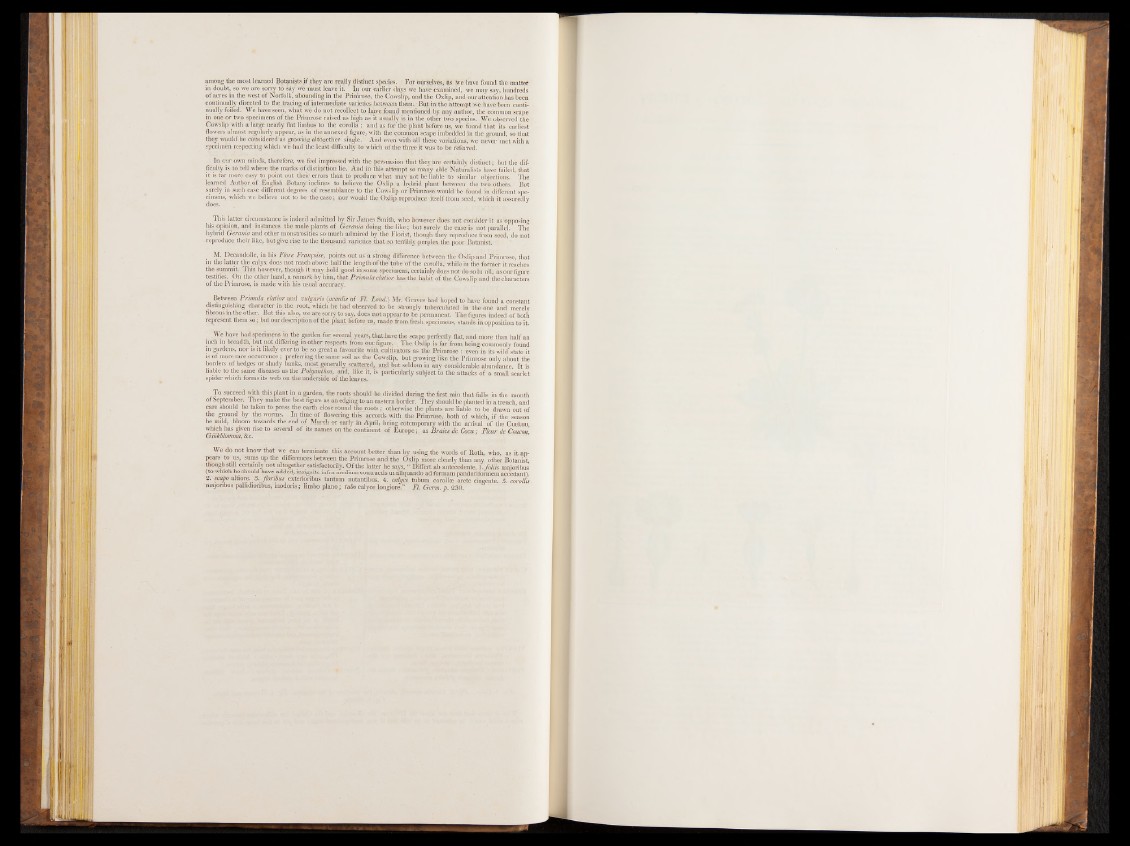
among the most learned JjJotynists if they are really distinct species. ' For ourselves, as Jive have found the matter
in doubt, so we are sorry to sày we must leave it. In our earlier days we have examined, we may say, hundreds
o f acres in the west of Norfolk, abounding in the Primrose, the Cowslip, and the Oxlip, and our attention has been
continually directed to the.tracing- of intermediate varieties between them.. But imthe attempt we have been continually
foiled. We haveseèn, what we do not recollect to havefoup^ mentioned by any author, the common scape
in one or two specimens of the Primrose raised as high as it usually is in the other two species. We observed the
Cowslip with a large nearly flat limbus to the corolla ; and as for the plant before us, we found that its earliest
flowers almost regularly appear, as in the annexed figure, with the common scape imbedded in the ground, so that
they would be cotisi'derfed as growing altogether single. And even with all these variations, we never met with a
specimen respecting which wè had the least difficulty to which of the three it was to be referred.
In cur own minds, therefore, we feel impressed with the persuasion that they are certainly distinct; but the difficulty
is to. tell where the marks of distinction lie. And in this attempt so many able Naturalists have failed, that
it is far more easy to point out their errors than to produce What may not be liable to similar objections. The
learned Author of English Botany inclines to believe the Oxlip a hybrid plant between the two others. But
surely in such case different degrees of resemblance to the Cowslip or Primrose, would be found in different specimens,
which we believe not to be the case; nor Would the Oxlip reproduce itself from seed, which it assuredly
This latter circumstance is indeed admitted by Sir James Smith, who however does not consider it asopposin®
his opinion, anc} instances the mule plants of Gerania doing the like; but surely the case is not parallel. The
hybrid Gerania and other monstrosities so much admired by the Florist, though they reproduce from seed, do not
■ reproduce their like, but give rise to the thousand varieties that so terribly perplex the poor Botanist.
M. Decandolle, in his Flore Françoise, points out as'a strong difference between the Oxlip and Primrose, that
in the latter the calyx does not reach above half the length of the tube of the corolla, while in the former it reaches
the summit. This howeveY, though it may hold good in some specimens, certainly do.es not doso in all, as our figure
testifies. On the other hand, a remark by him, that Primula clatiov has the habit o f the Cowslip and the characters
of the Primrose, is made with his usual accuracy.
Between Primula elatior and vulgaris (acaulis of FI. Loud.) Mr. Graves had hoped to have found a constant
distinguishing character in the root, which he had observed to be strongly tuberculated in the one in d merely
fibrous in the-other. But this also, we are sorry to say, does not appeal-to be permanent. The figures indeed of both
represent them so ; but our description of the plant before us, made from fresh specimens, stands in opposition to it.
We have had specimens in the garden for several years, that have the scape perfectly flat, nnd more than half an
inch in breadth, but n ot differing in other respects from our figure. The, Oxlip is far from being commonly found
in gardens, nor is it likely ever to be so great a favourite with cultivators as the Primrose : even in its wild state it
is of more rare occurrence ; preferring the same soU as the Cowslip, but growing like die Primrose only about the
borders of hedges or shady banks, most generally scattered, and but seldom in any considerable abundance I t is
liable to the same diseases as the PolyaMhos, and, like it, is particularly subject to the attacks of a small scarlet
spider which forms its web on the underside of the leaves*
To succeed with, this plant in a garden, the roots should be divided during the first rain that falls in the month
of September. They make the best figure as an edging to an eastern border. They should be planted in a trench, and
care should be taken to press the earth close round the roots ; otherwise the plants are liable to be drawn out of
the ground by the worms. In time of flowering this accords with the Primrose, both of which, if .the season
be mild, bloom towards the end of March or early in April, being cotemporary with the arrival of the Cuckoo
which has given rise to several of its names on the continent of Europe ; as Braies de Cocu : Fleur de Coucou
Gïôkblomma, &c.
We do n ot know that we can terminate this account.better than by using the words of Roth, who, as i t appears
to us, sums up the differences between the Primrose and the Oxlip more clearly than any. other Botanist
though stall certainly not altogether satisfactorily. O f the latter he says, “ Differt ab antecedente, 1 . foliis majoribus
(to which he should have added, insignite infra medium contractas u t aliquando ad formam panduriformem accédant).
2. scapo altiore.. 3. floribus exterioribus tantum nutantibus. 4. calyce tubum corollæ arete cinvente. 5. corollis
majonbus pallidioribus, inodoris; limbo piano; tubocalyce longiore.” Fl. Germ.p. 230. °